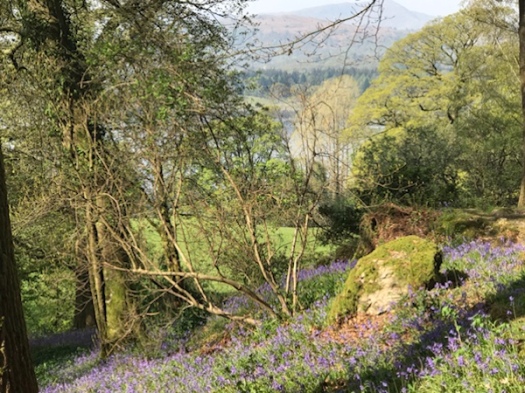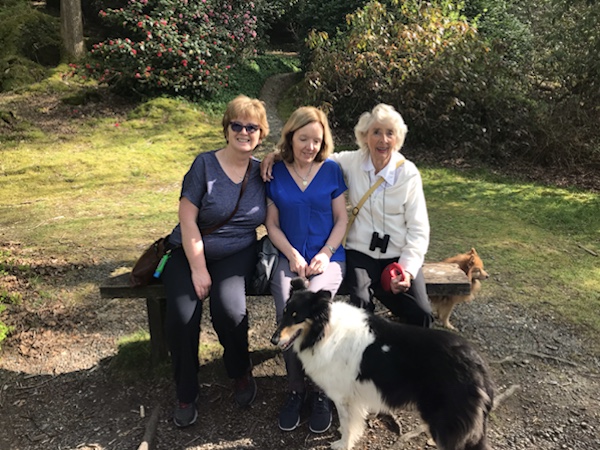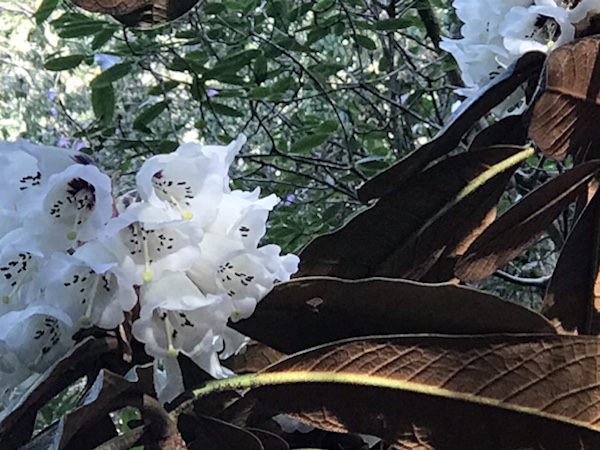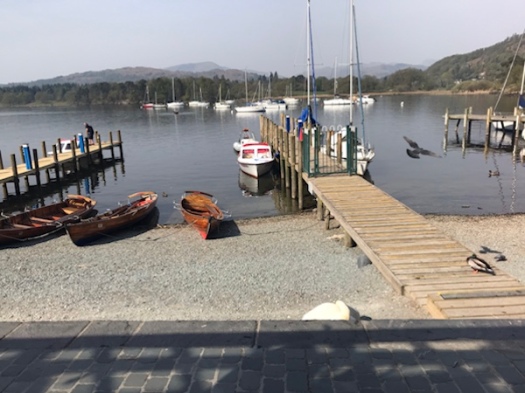
Stagshaw Garden is a sloping woodland garden of approximately eight acres. It is located on a steep slope named Skelghyll Fell on the north-eastern shores of Windermere, England’s largest lake. The area around Windermere is considered the centre of the Lake District. The word ‘Lakeland’ has become a normal way of referring, locally, to the Lake District.
Most of the Lake District is protected by the National Trust – a preservation organisation which was founded in 1897 and empowered by an Act of Parliament in the early years of the twentieth century. Beatrice Potter, the children’s author, was one of the founders of the National Trust. She lived in Lakeland and bequeathed her substantial local landholdings to the Trust at its formation.
Stagshaw Garden was created for the National Trust by Cubby Acland. The project was begun in 1959 and continued to his death in 1979.

Acland was a local travel author and a Land Agent for the National Trust. He lived in one of the country houses on the edge of what became Stagshaw Garden and was intimately familiar with the layout of Skelghyll Fell – within which the present garden was created and landscaped. The entire Wansfell Estate passed into the hands of the National Trust in 1957.

We are lucky to live in Kendal; a half-hour’s drive from the shores of Lake Windermere. Many of our relatives like to visit… Easter is popular, as the ‘coming alive’ of the local landscape is very tangible at that time.
For this Easter weekend, we had my mother and Bernie’s sister staying with us. My mother is eighty-nine and has vascular dementia. Although she has a full life – and is still independent – her attention span is short, so we try to construct days out which compensate for this and give her the happiest family memories for as long as she can retain them…

We have learned from experience that getting out early in the day is the key to a successful trip; as is filling it with a number of relatively short activities. This gives her time to relax in the afternoons, back at our house, and not get too tired by the day.
Stagshaw Garden is an easy walk (following an initial short climb) and so was an ideal choice for our morning, which called for a first visit of about an hour. Having decided this, we wrestled everyone out early and arrived just after nine-thirty, enjoying the unusually light traffic for such a popular weekend…


The garden is steep, but accessible. It follows the ravine created over millennia by the descending stream. It is famous for its shrubs, especially rhododendrons, azaleas and camellias.

From the rustic wooden gate, the path winds up to the right and begins to follow the stream valley that climbs the hill. This forms the core of the garden.

It was still before ten in the morning and the light had that special spring-like quality to it. Everything seemed extra bright, and the colours – particularly the greens – were vivid and sumptuous.

When Bernie and I retired from our former life in IT, she went back to college to qualify in horticulture – something she had always wanted to do – and now volunteers with Cumbria in Bloom, part of the RHS’ work of promoting gardens.

Neither of us had ever visited Stagshaw Garden, but it was on our list, largely because Bernie is fascinated by the kind of landscape design that moulds itself into a difficult landscape – such as a long gulley on the side of a Lakeland fell…

The trick, she explained, was to make it look completely natural; to take the visitor on a journey that looked as though its path has always been there, winding and climbing through the changing forest.

We were delighted to find a section of bluebells at the highest point of our climb. A deer also made an appearance but ran off too quickly to photograph. We had reached the limit of what Mum could cope with – but we had promised her bluebells… Their sudden appearance at this high-point made her morning.

From our partial ‘summit’, two paths led back down through the garden. The first was the way we had come. The second offered us an alternative descent which gave us an unexpected view of Cubby Acland’s former home.

Ahead lay a visit to Waterhead, a coffee and an unexpected scone with local jam and cream; followed by the ruin of a Roman Fort and a dog chasing a frisbee… but that’s probably enough for one post! A very happy but tired mother returned home by the early afternoon for her nap…

©Stephen Tanham 2020
Stephen Tanham is a Director of the Silent Eye School of Consciousness, a not-for-profit teaching school of modern mysticism that helps people find a personal path to a deeper place within their internal and external lives.
The Silent Eye provides home-based, practical courses which are low-cost and personally supervised. The course materials and corresponding supervision are provided month by month without further commitment.
Steve’s personal blog, Sun in Gemini, is at stevetanham.wordpress.com.




























Reblogged this on Sue Vincent's Daily Echo.
LikeLiked by 1 person
Thank you, Sue x
LikeLiked by 1 person
How beautiful and fun!
LikeLiked by 1 person
It’s great. Put it on your list!
LikeLiked by 1 person
A bit far from Indiana, but, hey, who knows?
LikeLiked by 1 person
You never know… and if you come to Britain, it should be on your list – rather a long way from London, though!
LikeLiked by 1 person
Thank you. What a lovely outing…. Have only been to the Lake District once, and it was beautiful, but partly rather wet…Gorgeous scenery though and a memorable visit to The Drunken Duck pub…
LikeLiked by 1 person
Thank you, Joy. The Lake District’s natural state is wet… that’s why it’s such a joy to get the kind of weather we have just had for Easter. The photos don’t really do it justice so come and visit!
LikeLike
The garden looks beautiful. My place is totally flat; gardening in a ravine would be interesting and maybe a challenge. And isn’t Lake Windermere where Arthur Ransome’s Swallows and Amazons books were set?
LikeLiked by 1 person
It’s quite compact but very beautiful, Audrey. Swallows and Amazons was set in the Lake District, but on Lake Coniston, which is a few miles west of Windermere. As a young teen, I found a little island there and persuaded my dad to let me take the family’s dinghy to land there – what excitement! Years later, I found out it had been Ransome’s inspiration for the island in the story…
LikeLiked by 1 person
Coniston, of course! I knew that but had forgotten. At least I remembered the district correctly. How exciting to visit an island that might have been the one! Thanks for sharing that memory, Steve.
LikeLiked by 1 person
There is s beautiful steam gondola that, during the season, does a triangle around Coniston. It’s quiet and smooth, seats about forty people, and gives a great tour of the lake. On one of the legs of the trip the captain pointed out ‘my’ island and said it was the one that Ransome used as the basis for that in the story. So, many years on, my theory was confirmed…. a lovely adult moment that took me back, like a time machine, to my teens! 😎
LikeLiked by 1 person
Delightful!
LikeLiked by 1 person